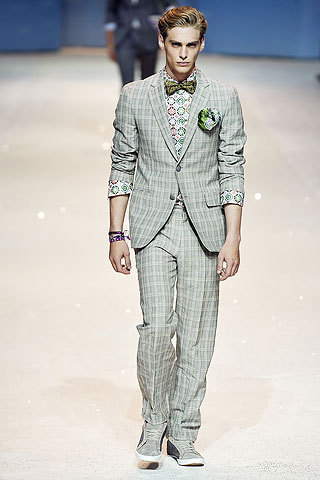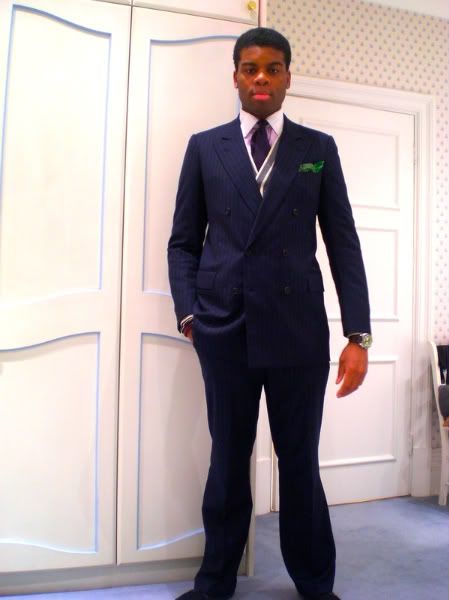I'd never known a fashion collection speak so directly to what I feel could be my idealised aesthetic, particularly in the summertime. After all, for this moment, I've almost achieved it. I'm happy to thrift, to inherit, to use eBay, to go High Street and discerningly acquire at deep discounts, but the JW CdG Man S/S08 show had me considering its extraordinarily high retail prices with genuine intent
And that almost never happens


It was the show that sealed my fate. The average runway presentation puts my mind in one of about 3 places: "must have the entire outfit" "would wear that jacket, nix the trousers," "what the hell is that meant to be?" While the latter two speak for themselves, I've never actually purchased and worn an entire runway outfit - this isn't "Monkey See Monkey Do" - nor have I worn an outfit entirely inspired by one. But I've come so very close to this and the current summer collection, and it isn't hard to appreciate why
With the exception of the more outré ensembles featuring effervescent paisley shorts, sportcoats or trilbies - perhaps
de rigueur for the likes of Patrick McDonald on a resort vacation - the show presented an improbably sustainable run of desirable appearances that flirted with practically every trend that has seen men's fashion through the last few years, pushed the bounds of Watanabe's self-imposed traditionalism for all it was worth and somehow ended up as the last word in contemporary dandy gear
 It's particularly notable, and impressive, just how much different a lanky man looks in the Lacoste safari jacket compared to myself
It's particularly notable, and impressive, just how much different a lanky man looks in the Lacoste safari jacket compared to myself

Certainly, something of a mannered, elusive, better-dressed-than-all spirit pervaded matters. The models's walks intermingled with the stationary gathering of the guests, who stood and assessed the viewing in an austere, brightly lit space, waited on by an impeccable man in a double breasted white jacket and a black silk necktie. One of the models was snapped whistling through a turn and doffed his dark Panama hat to the waiting photographers, while another strode with nonchalant ease, a hand in his pocket and confidence and haughtiness hinted across his face. Yet such mannerisms seemed rather unplanned and in full accord with the theme that Watanabe aimed for, terming his creations "Relaxed Suiting"
This was very much a presentation for the smart dresser who wore his clothes to live, much in the manner that dear old Fred Astaire would roll up and throw his freshly bespoke suits against the wall to rid them of their "newness." And roll ups were certainly driving many of the ideas. The wrinkles evident in so many of the garments were created by tightly tying them into a ball and leaving them overnight. Meanwhile, every single trouser on show was roll cuffed for maximum offbeat elegance (and some jacket sleeves too)


Having seen and purchased some of the clothes, I can confirm that they're a genuine delight, but the true value certainly lies in its tailoring. A Lacoste safari jacket made out of recut, overdyed polo shirts and utilising features such as armpit guards could quite possibly be the apex of lightweight outerwear, but the other collaborations were just as thrilling. A short safari suit made out of Brooks Brothers Oxford cloth was similarly inventive, while the ante was upped on the longterm Levi's collaboration when Watanabe actually recut the jeans jackets into sportcoats and safari jackets rather than simply cutting them in different fabrics as before, though the gingham cloth certainly helped in that regard
The own label jackets were just as charming - aside from the wrinkles, there was variety to be had in four front patch pockets; foulard or floral print half lining; leather and elbow patchwork; the memorable coffee bag redesigns; madras blazers; cotton, linen, ramie; and a variety of warm weather weights. Some were so thin a camera flash could expose the lining for a single instant and if that wasn't enough display, some of the jackets inventively featured their lining above the second button on a 3-button configuration, displayed by rolling the first button point into the lapels (3 roll 2, so goes the parlance)
And the JW shorts suit, 2 years on, is still about the only take that doesn't seem wholly silly. The proportional balance of matching a shorter jacket to knee length shorts and opting for a cut with a slimmer, rather than skintight, waist and natural shoulders made them an enticing proposition


Other strong showings came from the knitwear designs, which were heavy on classic argyle and cricket stripes arranged in a less conventional manner and rendered in bolder, yet considered, colours than by, say, Gucci. The shirts were also delightful and progressed from plain pastels to the currently-ubiquitous gingham to wrinkled foulard-printed shirts. My inner Jermyn Street fanatic was immediately sold by the emphasis placed on French collars, and only a little disappointed that the matching white cuffs were not designed for links. The appearances of the latter shirts were matched to colourful, candy striped loose-fit trousers that appeared initially uneasy, but ultimately seemed to cohere into a witty take on current pyjama-derived dressing
The preference for smart, sturdy shoes also worked to keep the collection grounded (per se), and were accurately matched to the shorts, chinos and jeans. And the hats were simply fantastic; varied in colour, style and hue, the hatbands composed of the same print cottons as the linings, shirts and jackets. Watanabe was so enamoured of them that he used both the men's and women's hats in each show.
As he is wont to do, the later women's collection was a fantastical version of this one, utilising the cricket jumper, reworking the shirts into floaty, voluminous wrap dresses or short jumpsuits and even creating a women's version of the panelled, stitched charcoal suit that could be bought with either matching trousers or a shirt. No one riffs on a theme the same way Watanabe can


And what of the themes? One of the similarities I neglected to include in
the previous dissection was a resemblance to Paul Smith’s A/W 03 collection; all sturdy shoes, country checks and somewhat boxy, slim-and-short-cut suiting. This had a beguilingly subdued mix of youthful Paul Smith-esque colours with Etro-like patterns and emphasised a much more European outlook to Junya's work this time. Although his traditional manifesto always holds true, Watanabe is often considered to be an American nostalgist and the instinct was strong amongst some to connect the pastel pieces, cricket v-necks and short suits to Thom Browne and preppydom. And this would be selling the wide-ranging styles of the pieces rather short
Indeed, a variety of influences can be gleaned if one looks closely. Naval stripes and the prints suggested early 20th century seafaring and resort holidays. The coffee bag theme and the messy formality put one in mind of Deep South river workers, just the types to roll up their cuffs and get soaked, emerging with clothes shrunken and clinging to their frames. And Frillr.com, recognising that there is no single overriding influence, memorably described the aesthetic as "
a Coffee worker born in Italy, raised in New York around the 50s, who then went west and worked at some farm with Thom Browne"
But I think my fellow StyleForvm member, Fuuma, was particularly accurate in citing Lanvin as an influence, pointing out that the European dandyism, "manchild mash-ups" (an all-ages appeal exemplified by the varying ages amongst the models), nontraditionally cut suiting and washed, wrinkled smart fabric was straight out of the Elbaz & Ossendrijver playbook, albeit filtered through Watanabe's own wilder and personalised insights. And such a recombinant form of dress speaks highly of his unerring eye for hybridisation

I'm still in love with much of this, two years after I first saw the photos. A different way of looking at tailoring but without sacrificing good taste and a gentleman's attention to detail. Wonderful colours and a laid back presentation. Smart shoes, smart socks, smart hats
Glib as this may be, who says tradition is boring? Or that it should not co-exist with high fashion? Not Junya Watanabe - and clothing is all the better for him
 Your author trying on his JW wrinkled sportcoat with floral lining. It will see many more outings in better weather, though I think the buttons may have to be changed
Your author trying on his JW wrinkled sportcoat with floral lining. It will see many more outings in better weather, though I think the buttons may have to be changed



































































